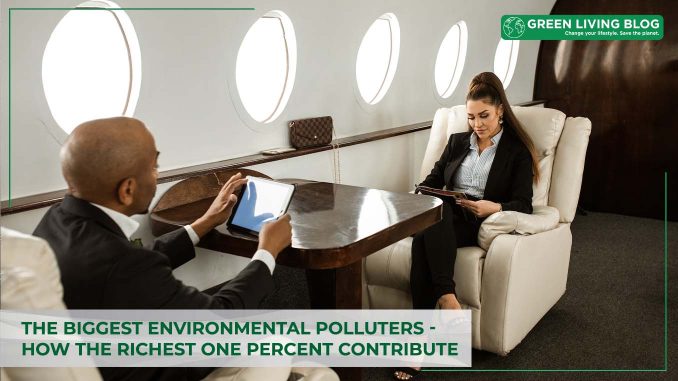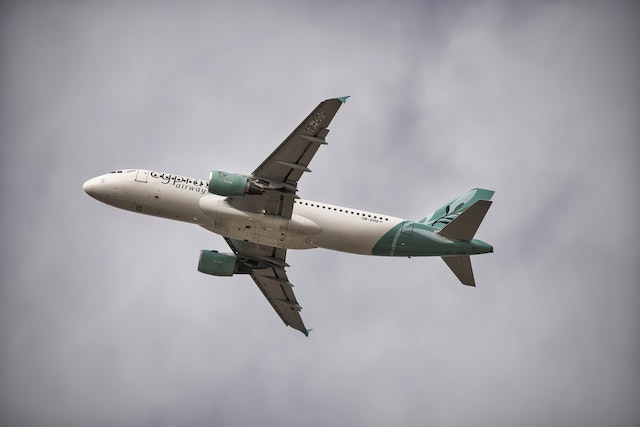
We are all aware of the pollution issues that dominate the news and which governments and companies across the world are attempting to tackle.
However, what’s often not so well known is that the world’s richest 1 per cent contributes a significant portion of the overall pollution.
We, therefore, delve deeper into this subject, looking into how the wealthiest individuals and organisations have become the biggest environmental polluters and what actually causes the biggest pollution impact.
We have identified two main means of private transportation causing the biggest environmental pollution impact: private jets and yachts.
Read on to discover more.
The Biggest Commercial & Private Plane Polluters in the World
Air travel is one of the fastest and most convenient ways to get around the world, but it also comes with a huge environmental cost.
According to the International Council on Clean Transportation (ICCT), aviation accounted for about 2.4% of global CO2 emissions in 2018, and this share is expected to grow as demand for air travel increases.
Commercial Plane Pollution

The carbon footprints of different airlines are not uniform. The amount of CO2 emitted from an aircraft depends on multiple factors such as fleet age, fuel efficiency, load factor, route network, and operational practices, which varies from airline to airline.
We, therefore, look at some of the biggest plane polluters in the world, based on the latest data from the ICCT and explore some of the ways that airlines can reduce their emissions and make air travel more sustainable.
The Top Commercial Plane Polluters in the World
The ICCT ranked the below 20 airlines based on their passenger-based fuel efficiency in its Transatlantic Airline Fuel Efficiency Ranking in 2017.
Factors investigated by ICCT include aircraft fuel burn, seating density, passenger load factor, and freight share of total payload. Of these, aircraft fuel burn was found to be the most important driver overall.
Below are the airlines offering transatlantic passenger routes ranked based on their fuel efficiency, starting at the top with the most efficient and least polluting, down to the least efficient and most polluting.
List of smallest to biggest commercial plane polluters:
- Norwegian Air
- WOW Air
- SWISS
- KLM
- Turkish Airlines
- Air France
- Thomas Cook
- Virgin Atlantic Airways
- Icelandair
- Iberia
- Delta
- Scandinavian
- American
- Austrian
- Aer Lingus
- Alitalia
- Aeroflot
- United
- Lufthansa
- British Airways
According to this ranking the biggest commercial plane polluters are some of the most used airlines such as BA and United, which indicates that these companies should urgently review their sustainability and passengers should think twice before choosing them.
Current projections suggest that the demand for air passenger travel in the year 2050 could surpass 10 billion journeys. However, if we continue on a “business as usual” trajectory, the anticipated carbon emissions between 2021 and 2050 are approximately 21.2 gigatons of CO2. It is therefore of utmost importance to bring down the carbon emission from the biggest polluters in the aviation industry to achieve the ambitious carbon neutrality goals many nations have established.
Private Jet Pollution – the Facts
According to the survey report by Transport & Environment, a European campaign organisation for clean transport, private jets cause 5 to 24 times more pollution than commercial flights and 50 times more than trains. This gap is expected to widen as private jet users are more likely to choose larger and more luxurious aircraft which consume more fuel and result in emitting more greenhouse gases.
🚨BREAKING🚨 CO2 emissions from private jets are rising faster than commercial aviation emissions
According to our new report, #PrivateJets are:
✈️10x more carbon intensive than airliners
✈️50x more polluting than trainsRead #PrivateJetsPay:https://t.co/Qq2azDCnP8 pic.twitter.com/fopqGoV7Dn
— Transport & Environment (@transenv) May 27, 2021
The worst offender of private jet pollution is the UK in Europe. It has more flights than any other place on the continent. According to the survey, once every six minutes, a private jet took off from the UK. It results in emitting 500,000 tonnes of CO2, which is more than any other country in Europe. It has been found that many of those flights were short-haul flights, which could be easily replaced by any other means of transportation, even by cycling.
There were about 182 non-commercial flights into Glasgow, Prestwick, and Edinburgh airports for the COP26 summit in 2021, which is about double the total for the previous six days.
Private jet travel is not only harmful to the environment but also to social justice.
Previous research has found that 50% of all aviation emissions were caused by 1% of the world’s population.
This means that a wealthy minority is contributing disproportionately to the climate crisis, while millions of people around the world are facing its devastating consequences with natural disasters such as droughts, floods, wildfires, and displacement.
Private jets are 10 times more carbon intensive than commercial airliners so the focus for reducing carbon emissions should be on private plane polluters.
In just one hour, a single private jet can emit two tonnes of CO2. In comparison, the average person in the EU emits 8.2 tCO2eq over the course of an entire year.
Private jet passengers account for 10 times as many greenhouse gas emissions as commercial travellers, and 150 times more than train travellers.
How can Plane Pollution be Reduced?
Now, the question arises of what can be done to reduce the use of private jets while making aviation more sustainable. Imposing higher taxes on private flights can be one possible solution. In many countries, these taxes are exempt from fuel taxes and VAT.
This will make private flights expensive; potential users will be less attracted towards it and in the meantime, the revenue generated could be invested in green transport alternatives.
Another option is zero-emission aviation technology; it might eliminate or at least reduce the CO2 emission rate from flying.
As the airline industry faces pressure to reduce its carbon emissions—sustainable aviation fuel could help with meeting 65% of targets. It’s an expensive process, however, and one that might lead to a 22% jump in airfare for the consumer by 2050. https://t.co/4gqxVK8SGo
— Forbes (@Forbes) May 2, 2023
Several interventions can be adapted by commercial airlines and private jet owners that can improve fuel efficiency and lower the CO2 emissions of their aircraft, such as:
- The inefficient and older models of aircraft should be replaced with newer and more efficient models, such as the Airbus A350 and Boeing 787.
- Optimising the route network and flight schedules to reduce unnecessary flying and avoid congested airspace.
- The use of available capacity in an aircraft should be increased by maximising their load factor (the percentage of seats filled by passengers).
- Implementing operational measures to reduce fuel consumption, such as reducing weight, optimising speed and altitude, minimising taxiing and idling time, and using single-engine taxiing.
- Using biofuels as alternatives to fossil fuels, such as biofuels or synthetic fuels, that have lower carbon intensity than conventional jet fuel.
- Participating in carbon offsetting or carbon pricing schemes, such as the Carbon Offsetting and Reduction Scheme for International Aviation (CORSIA), that require airlines to compensate for their emissions by investing in emission reduction projects or paying a carbon tax.
The Biggest Yacht Polluters in the World

Yachts are a symbol of luxury and wealth, but they also have a huge environmental pollution impact, which is often unnoticed.
According to a report by Transport & Environment, yachts emit more carbon dioxide (CO2) per kilometre than any other mode of transport, including cars, planes and trains.
According to their survey, the fuel consumption of yachts per passenger is higher than cruise ships, which are already notorious for their pollution.
The size and speed of the yachts are one of the main reasons for the pollution caused by them. An average yacht is nearly 40 metres long and it can accelerate up to 30 knots (55 km/h). They require powerful engines to achieve such speed, which requires the engines to burn huge amounts of fuel.
According to superyachtcontent.com, a 70m yacht travelling 100 nautical miles with the engines burning 1000 litres per hour would consume 8335 litres for that passage, which translates to about 1.2 tons of CO2 emissions. In comparison, a car emits about 0.12 tons of CO2 per 100 kilometres.
One of the other reasons for private yachts being harmful to the environment is their waste disposal procedure. Most of the yachts do not have the appropriate systems to dispose or treat that are produced, they end up dumping the garbage and sewage into the sea.
This is creating serious damage to marine biodiversity and a major imbalance in the marine ecosystem, as well as posing health risks to humans and animals. Some yachts are cleaned with chemical cleaners, which end up in the sea, contaminating it.
The yacht industry is aware of its environmental impact and has taken some steps to reduce it.
For instance, some yacht builders have started to use more eco-friendly materials and technologies, such as solar panels, hybrid engines and biofuels.
Some yacht owners have also adopted more sustainable practices, such as using less water and electricity, recycling their waste and offsetting their carbon footprint.
The measures taken are not yet enough to result in significant change as environmental regulations, laws and standards are not enforced and therefore considered by yacht owners.
In addition, the demand for yachts is growing in markets like China and India, which are considered to have lower environmental awareness.
Therefore, it is important for yacht owners and users to take responsibility for their actions and choices. They should be aware of the environmental impact of their yachts and seek ways to minimise it.
They should also support initiatives that promote green yachting and follow stricter regulations and policies. By doing so, they can enjoy their yachts without compromising the health of the planet.
Closing Thoughts
In conclusion, private yacht and jet travel by the richest one per cent living on this planet is a major contributor to environmental pollution and social inequality that needs to be addressed urgently. Sadly, governments mainly focus on initiatives and policies for the wider population, without encouraging the wealthiest one per cent to do their bit. By raising more awareness, imposing stricter regulations, and supporting innovation, we can hope to make private transportation and travel less harmful to the planet and all its inhabitants.
![]()
Author Profile
- Online Media & PR Strategist
- Blogger and Educator by Passion | Senior Online Media & PR Strategist at ClickDo Ltd. | Fascinated to Write Lifestyle Blogs in News & Education I have completed a journalism summer course at the London School of Journalism and manage various blogs.
Latest entries
 LeisureApril 16, 202510 Best Green UK Hotels for Eco-Tourists
LeisureApril 16, 202510 Best Green UK Hotels for Eco-Tourists Best practicesApril 14, 20258 Best Ways to Reduce Your Carbon Footprint
Best practicesApril 14, 20258 Best Ways to Reduce Your Carbon Footprint Green Expert GuidesMarch 28, 2025Lisbon Living: Where Sustainable Charm Meets Urban Energy
Green Expert GuidesMarch 28, 2025Lisbon Living: Where Sustainable Charm Meets Urban Energy EnvironmentJanuary 21, 2025Buying Eco-Friendly Homes: 6 Eco Questions to Ask Your Real Estate Agent
EnvironmentJanuary 21, 2025Buying Eco-Friendly Homes: 6 Eco Questions to Ask Your Real Estate Agent






Leave a Reply
You must be logged in to post a comment.